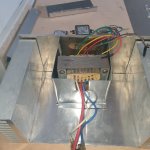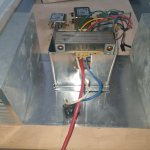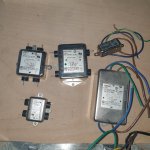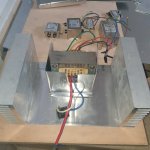Thanks for the reply, I am a bit wary of the SMPS power supplies, just wondering if it is worthwhile going the regulated linear supply or cap multiplier as shown in the JLH documentation - or just plain old transformer, bridge rect and heaps of caps.
I have Mean Well LRS-100-24: https://www.meanwell.com/Upload/PDF/LRS-100/LRS-100-SPEC.PDF.
Thinking to get the Mean Well LRS-150-24: https://www.meanwell.com/Upload/PDF/LRS-150/LRS-150-SPEC.PDF, for this project.
Thinking to get the Mean Well LRS-150-24: https://www.meanwell.com/Upload/PDF/LRS-150/LRS-150-SPEC.PDF, for this project.
Last edited:
I found one that states 1500uF max on the load probably due to the retailer that sells it - to amateurs. Pass really but noise on these is usually measured over a 20MHz bandwidth, couple of capacitors and twisted pair. I haven't a clue what that would do on an audio amp. It would cost £16 to find out, Ripple anyway is over 10x Hood's capacitor multiplier.Switch mode likely
wouldn't tolerate much more the 450uf to 1000 uf max
🙂 I'm more interested in the amp and can stuff that is available now improve the measured performance.
its just a fun quick circuit to see what .1% distortion sounds like.
Going single supply is the main reason to use common switch modes.
So as noted you dont need to spend a ton of money to find out what a hot 10 watt amp does.
putting together a large capacitance linear supply not to bad at this voltage.
just some people get caught up with tossing really expensive components that wont
really change a 10 watt amp. or dealing with ripple in audible range opposed to high frequency.
you can get .01% distortion and same harmonic profile. By just adding a additional feedback loop
common with these old topology's.
Most people dont go over 8 ohms. With 4ohms you need a larger output cap.
So its just a old practice to add the feedback after the cap to reduce the size needed
and improve THD.
Some people really enjoy board design and spend time with that. or like making everything
"adjustable" so go for it if that is your pleasure
It is really not needed. like any single supply, you need to be at half supply at the output.
and just slightly towards the positive side by .2 / .5 volts. Current at 1.3 amps when your at temp.
Why I tossed redundant amount of output devices. Weasel a volt or 2 more output and current is easier to measure
with emitter resistors. You just find set resistor values and she's good to go. why I use redundant resistor in the voltage
ref at input. So you dont get odd resistor values. you can dial it in with everyday 10% values since you have course and fine
tune values using 2 extra resistors.
Going single supply is the main reason to use common switch modes.
So as noted you dont need to spend a ton of money to find out what a hot 10 watt amp does.
putting together a large capacitance linear supply not to bad at this voltage.
just some people get caught up with tossing really expensive components that wont
really change a 10 watt amp. or dealing with ripple in audible range opposed to high frequency.
you can get .01% distortion and same harmonic profile. By just adding a additional feedback loop
common with these old topology's.
Most people dont go over 8 ohms. With 4ohms you need a larger output cap.
So its just a old practice to add the feedback after the cap to reduce the size needed
and improve THD.
Some people really enjoy board design and spend time with that. or like making everything
"adjustable" so go for it if that is your pleasure
It is really not needed. like any single supply, you need to be at half supply at the output.
and just slightly towards the positive side by .2 / .5 volts. Current at 1.3 amps when your at temp.
Why I tossed redundant amount of output devices. Weasel a volt or 2 more output and current is easier to measure
with emitter resistors. You just find set resistor values and she's good to go. why I use redundant resistor in the voltage
ref at input. So you dont get odd resistor values. you can dial it in with everyday 10% values since you have course and fine
tune values using 2 extra resistors.
Good to be wary: my limited experience has some very good and some very bad SMPS. Bad in terms of cheap, nasty, short lived and Bad in terms of massive amounts of wideband noise.Thanks for the reply, I am a bit wary of the SMPS power supplies, just wondering if it is worthwhile going the regulated linear supply or cap multiplier as shown in the JLH documentation - or just plain old transformer, bridge rect and heaps of caps.
The good ones (including some $$$$ MIL-STD stuff) were good. The problems of, and solutions for, the various analog solutions are pretty well known. But I'd probably run for batteries + supercaps before I'd use plain ol'bridge-rect-and-caps. Even with schottkies or snubbers it's going to generate lots of noise. And the more caps you add, the worse that noise is going to get.
Excellentenjoy the music. MOst important part
I've used a few cheap and also somewhat expensive (Meanwell midrange quality) SMPSs with JLH and a few other class A amplifiers. Once you get used to not needing kilograms of iron and copper any more, you should find the sound quality is fine with a reasonable quality type - at least as good as a typical small toroid, rectifier and a bank of caps but don't waste money on cheap, unspecified SMPS units. The main benefit of regulation is that a simple rectified supply tends to be susceptible to line and EMI noise. Any type of regulator may also act as a filter to clean up line, rectifier and EMI noise, but in total, you'll be wasting more power than you use with linear PSUs.
Unless you are fearful of breaking with traditions, give SMPS a whirl - it's usually more than competitive on price at the midrange level and superior at the top.
Unless you are fearful of breaking with traditions, give SMPS a whirl - it's usually more than competitive on price at the midrange level and superior at the top.
Last edited:
Based on Ian's above post and the thumbs up from NP, what would be the recommendation for either the XP Power LCS100US24 or the Mean Well LRS-100-24. Both are 24VDC output at 100watts. I would use 2 supplies - one for each channel. Could even probably use a smaller 76watt unit for each channel - well within the current requirements for the JLH69. Could also implement a filter on the output as suggested by Mark Johnson in his TUBA thread, to clean up the output DC voltage.
I've not used any XP products but both the MW LRS series and XP LCS series power supplies are at the budget end of their respective product lines - they're intended to power LED lighting. So the supplies are cheap and there will be compromises but these guys are competitors in one way or another so I don't think any differences between their products will amount to much.
Thanks for the reply Ian, any suggestions as to a more suitable 'robust' model of SMPS to suit the JLH69 in your opinion.
;-)
Aside: Wooden transistor;-)
https://www.techspot.com/news/98514...ohFdSO2jGckVlxwsWJ3pHE_1JiJTYPBaQ7sRZPCGODDNs
Aside: Wooden transistor;-)
https://www.techspot.com/news/98514...ohFdSO2jGckVlxwsWJ3pHE_1JiJTYPBaQ7sRZPCGODDNs
Here you go Gary: HRP-200-24
https://www.meanwell.com/productPdf...X_jbyDjHdzyeY2_PSfkZ9t90T18SVT1oaAjapEALw_wcB
I use a pair of these wired in series for a bipolar supply to power my M2OPS amplifier.
https://www.meanwell.com/productPdf...X_jbyDjHdzyeY2_PSfkZ9t90T18SVT1oaAjapEALw_wcB
I use a pair of these wired in series for a bipolar supply to power my M2OPS amplifier.
I have only used switched mode power in class A builds for a few years now but I've learned that you don't gain a lot in sound quality by stifling them with light loads. I have both channels of Rod Elliott's P36 DOZ design amp. driven by a single supply at the moment and it sounds a little better that way, in that its stereo image seems more realistic than having each channel with its own supply. OK, this isn't a proper test method but I'm happier for some reason, with the stereo effects when using a single supply. Emphasizing the image with separate supplies would seem a good idea but doesn't seem to work well for me and it may require full "dual mono" construction to do what I was hoping to.any suggestions as to a more suitable 'robust' model of SMPS......?
Oops! timed out on post #9134.
To your actual question, Id buy just one LRS100 supply locally, as I did recently (just A$22ea + postage). Complete your build with a single supply and listen for a week or so before adding another or continuing with that type. You may be surprised at the difference or lack of it, if there is any in the program to begin with. Take care with local Ebay prices online - they seem to be different each time I access the sites.
To your actual question, Id buy just one LRS100 supply locally, as I did recently (just A$22ea + postage). Complete your build with a single supply and listen for a week or so before adding another or continuing with that type. You may be surprised at the difference or lack of it, if there is any in the program to begin with. Take care with local Ebay prices online - they seem to be different each time I access the sites.
Last edited:
The main difference between the cheaper LRS series vs HRP is the inclusion of power factor correction.
LRS = non PFC
HRP = with PFC
LRS = non PFC
HRP = with PFC
Hi. Because of i have transformer I made a shield for it from 1mm aluminum which also was in my storehouse. What is your opinion? Is it good or should I use stell sheet? I also have emi filters and maybe it also helps. Which filter to use? I have many of them.Do you think grounded or ungrounded is better for my application?
Attachments
Steel sheet, of course. Aluminium does not screen magnetic fields.
Aluminum is virtually transparent to magnetic fields so it won't do much or anything to shield your amplifier from the transformer's electromagnetic fields. You could shield low level audio circuits and PCBs with grounded ~1 mm steel and use shielded wire for audio signal leads to some benefit but with power transformers, distance and orientation (turn them around and listen) are the most cost-effective ways to reduce 100Hz hum.
- Home
- Amplifiers
- Solid State
- JLH 10 Watt class A amplifier



